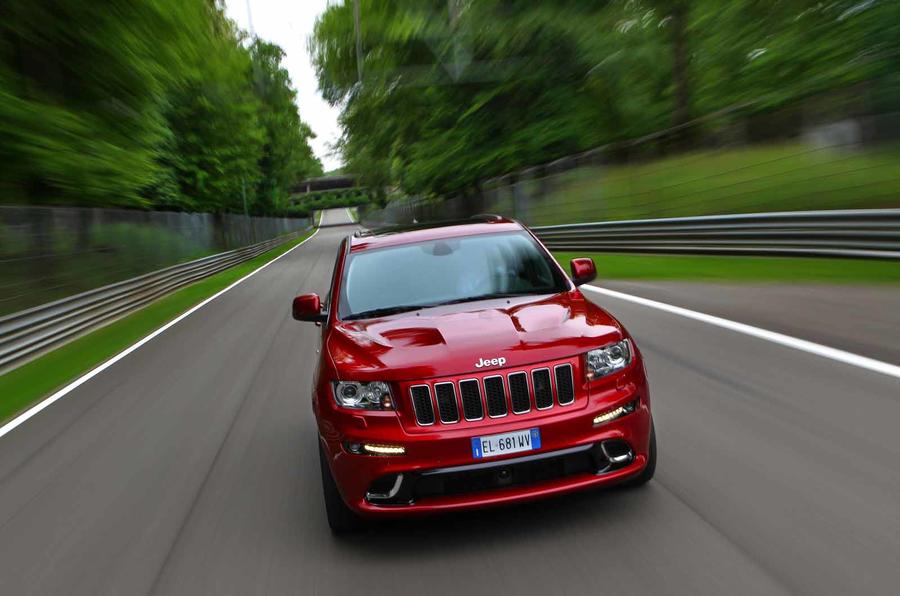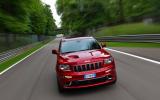What is it?
The Jeep Grand Cherokee SRT is the fastest and most powerful Jeep has ever produced, and it is utterly bonkers with it. Powered by a 6.4-litre Hemi engine that produces 461bhp and 460lb ft, it is the performance ‘halo’ model at the top of the American manufacturer’s Grand Cherokee range.
The SRT acronym denotes that the Grand Cherokee – which is great in standard form – has been worked over by Chrysler Group’s performance arm, Street and Racing Technology. The mission for SRT was to splice the performance and comfort of a high-class saloon with the all-wheel-drive practicality of an SUV.
The previous Grand Cherokee SRT had a 6.1-litre powerplant, which clearly wasn’t regarded as enough by Jeep. But the increase in capacity and performance isn’t the only change with this new Hemi. It also gets an active intake manifold and high-lift camshaft with cam phasing, which both help to optimise the power delivery across the rev range.
And although the Grand Cherokee SRT has the power to uproot mighty oaks, it also has one eye on hugging trees – a new ‘fuel saver’ system shuts off four of the eight cylinders when full power isn’t required. It’s an unobtrusive system – you only really notice due to the small ‘ECO’ symbol on the dash display. Still, this is by no means an eco-mobile, returning a claimed 20mpg on the combined cycle.
Helping this two-tonne 4x4 provide sporty handling is a steering system that’s been tuned for a more direct feel than a standard Jeep’s. The car’s active adaptive damping has been tuned by SRT, and is managed via the Selec-Track system that offers five modes: Track, Sport, Auto, Snow and Tow (the latter presumably being for those days when you want to combine flat-out hooning with load-hauling).
The aggressive styling adheres to SRT’s belief that every element of the design must be functional, not just for show. Compared to the base Grand Cherokee, the SRT is 25mm lower at the front and 35mm at the back. Together with a rear spoiler, flared wheel arches, black heat extractors on the bonnet, dual exhausts and a rear diffuser, it provides a muscular, aggressive stance, which is enhanced by the 20in five-spoke alloys the Grand Cherokee SRT rides on.
The interior is described by Jeep as ‘race-inspired’. That means there’s a leather steering wheel, SRT-badged Nappa leather and suede suits, a leather-clad gearknob, carbonfibre accents in the cabin and metal pedals.

























Join the debate
Add your comment
Sure Fiat, its really smart
Sure Fiat, its really smart to let the journalists test drive the SRT in Italy. Next time why not let them drive the new Ferrari in middle of Tokyo?
High Rider
Many miss the point that a higher suspension means better visibility. Vans, SUVs, minivans etc will no longer be able to obscure one's visibility.
Secondly driving through undulating, uneven ground is easier. Your less likely to damage your exhaust.
This SUV has reinforced shock absorbers and is better able to handle rough terrain compared to a sports car.
Increased visibility and improved passing acceleration makes overtaking large vehicles on B roads safer and swifter.
Most SRT8 drivers will always have the boring saloon on stand-by whenever they want to save fuel and take grandmum out!
To me, the SRT8 makes alot of sense!
High Rider
Many miss the point that a higher suspension means better visibility. Vans, SUVs, minivans etc will no longer be able to obscure one's visibility.
Secondly driving through undulating, uneven ground is easier. Your less likely to damage your exhaust.
This SUV has reinforced shock absorbers and is better able to handle rough terrain compared to a sports car.
Increased visibility and improved passing acceleration makes overtaking large vehicles on B roads safer and swifter.
Most SRT8 drivers will always have the boring saloon on stand-by whenever they want to save fuel and take grandmum out!
To me, the SRT8 makes alot of sense!